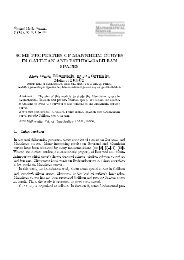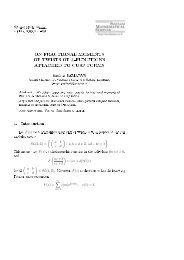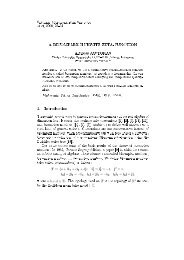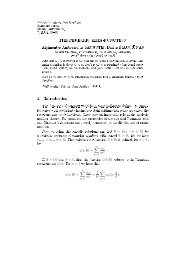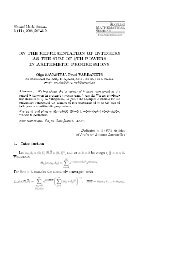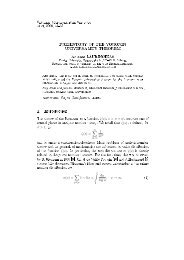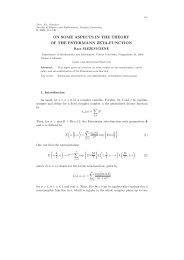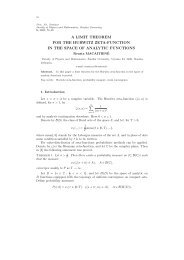POTENTIAL REPRESENTATION METHOD FOR WOODS-SAXON ...
POTENTIAL REPRESENTATION METHOD FOR WOODS-SAXON ...
POTENTIAL REPRESENTATION METHOD FOR WOODS-SAXON ...
You also want an ePaper? Increase the reach of your titles
YUMPU automatically turns print PDFs into web optimized ePapers that Google loves.
44 A. J. Janavi£ius, D. Jurgaitisintroducing the variable y instead of r, we obtain equation (7).We can represent the solution w(y) by power seriesw(y) =∞∑b n y n , (8)n=0which must be terminated [9] at some nite maximum power N. Only inthis case, eigenfunctions which exist in the region 0 y ∞ can be found.Substituting the last expression in equation (7) and expanding in thepower series (7), after equating to zero coecients of y n , we obtain the recurrentrelationse 0 n(n + 2L + 1)b n =n = 0, 1, 2, . . . , N, whereF (y) =N∑e m y m ,m=0n−1∑m=02ak(m + 2k + 2)e n−m−1 b m + cV 0 a 2 b n−2 , (9){e 0 = 1 + exp − R }a, e m = exp { − R am!}, (10)m = 1, 2, . . . , N. Taking in the care that in equation (9) must be b −1 = 0,b −2 = 0, we obtain that the power series begins from constant term b 0 . Nowall expansion coecients for solution (8) can be obtained from (9), (10). Forgetting eigenfunctions (6) from the power series (8), they must be abbreviated,and the coecients b N , for freely chosen N = 2, 3, 4 . . ., must be equalzero. In this case, we transform solution (6) to eigenfunctions u NL (r) witheigenvalues E NL dened by the quantum numbers N, L. However, calculationof eigenvalues k 2 by terminating of power series (8) at some nite maximumpower [9] in analytical form from recurrent relations (9) is complicated, andsome additional investigations must be provided.3. ConclusionsIn this paper, the analytical expressions of eigenfunctions (8) for Woods-Saxon potential are obtained using potential representation method. In thiscase, eigenfunctions can be expressed by potential and are represented bypolynomials with coecients satisfying presented recurrent relations. Weshowed that a potential representation method for positive energies and negativeenergies essentially diers. The analytical expressions of wave functionsu(r) = φ(V (r)) exp{∓ikr}, for any positive energy E > 0 and for L = 0,



